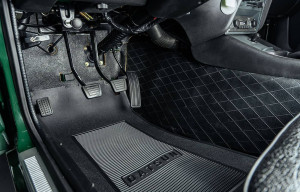One of the parts that you rarely notice, almost never consciously touch and hardly ever think about are the rubber floor mats that Nissan used, especially in the very first 240 Zs and Fairlady Zs in Japan.
These mats were available for the LHD and RHD cars. They were also available with and without DATSUN logo (in Japan, of course, they were without, as DATSUN was never named as the manufacturer of the Z).
After a relatively short time, these mats were "replaced" by carpet and are therefore almost unknown and of no relevance to almost any fan.
But that could change soon.
As our restored cars should match the factory specification down to the smallest detail, this naturally includes the rubber floor mats as well as various other parts.
An early Z without these mats? Impossible for us!
We have therefore spared no effort and, after several years of trying and misfiring, have finally produced exact copies. These can also be purchased in our shop.
But what makes these mats so special, and what is the story behind them? In this article, we want to get to the bottom of the matter and show you a few exciting details about what is actually a very unexciting part of our dream car.


 Florian Steinl
Florian Steinl 















